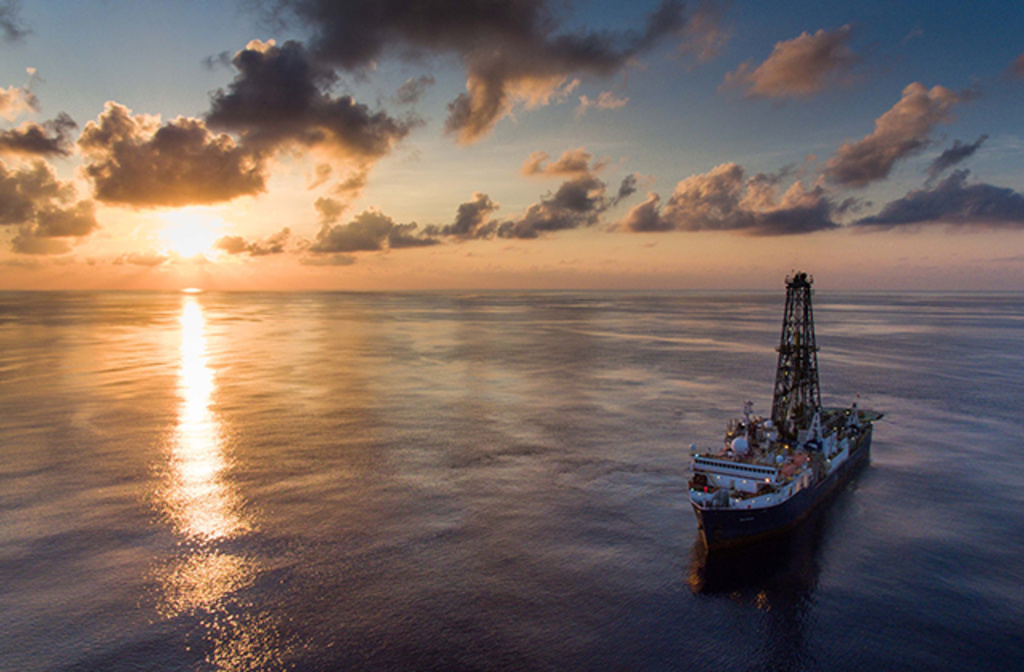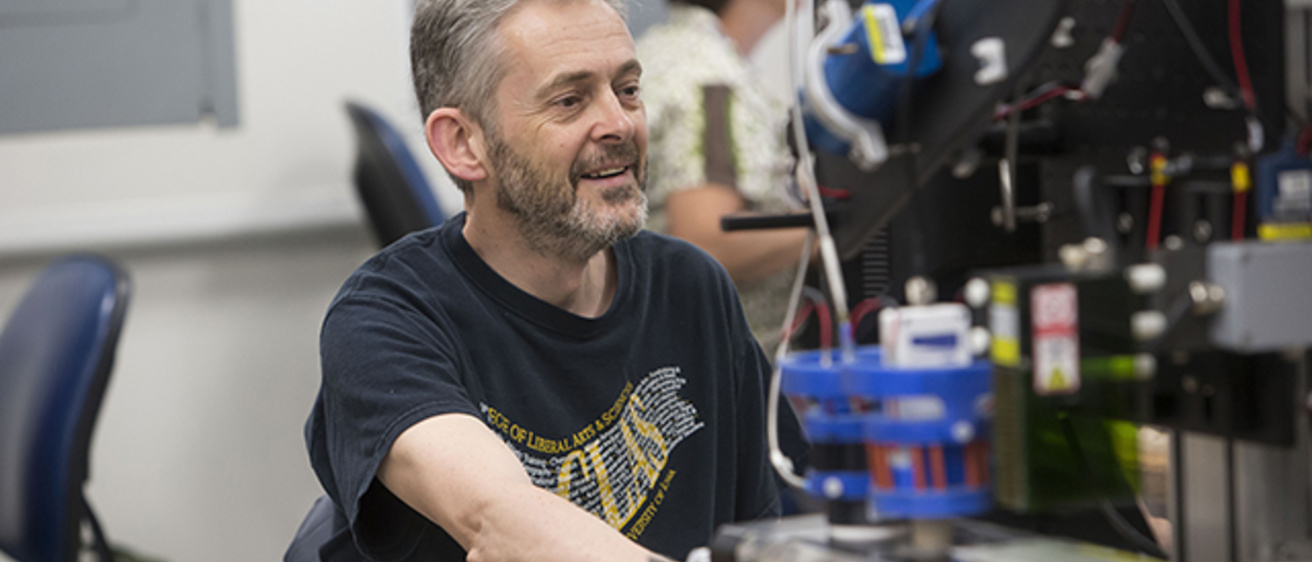David Peate, a professor in the UI’s Department of Earth and Environmental Sciences, is participating in an international expedition to learn more about how Earth’s continents evolved and how new oceans are created. During the expedition, funded by the International Ocean Discovery Program, Peate and other researchers are drilling cores in the seabed of the South China Sea, and some of those samples will come to the UI for analysis. Peate took time while still at sea to tell Iowa Now about the research—and life on the ship during the nine-week voyage.
What’s this expedition about?
The aim of the expedition is to better understand how the Earth’s continents break apart, or rift, to eventually form new oceans. These geological processes have gone on throughout our planet’s history, and the continents and the oceans we see today are the product of previous continents breaking apart and oceans being created.
The process, in general and simple terms, goes like this: When continents break apart, the uppermost layer, called the continental crust, is stretched and thinned. That creates openings for mantle rocks, located below the crust, to rise toward the surface. In some cases, those mantle rocks are heated up so much that they melt, producing lava flows that cover the continental boundaries, or margins, such as those seen today in Northern Europe and eastern Greenland. In other cases, the mantle rises up and is exposed at the sea floor with virtually no associated lava flow. We see that today in the margins off Newfoundland and Iberia.
What we want to understand is what causes the difference in those two rifting events. We do that by finding the rocks that are the byproducts of these long-ago events. One such place is in the South China Sea, where the rocks we’re interested in are at a shallow enough depth below the sea floor for us to access through drilling. We are using the R/V Joides Resolution ship operated by the International Ocean Discovery Program (IODP) to drill for samples from the South China Sea rifted margin.
Why are you gathering samples in the South China Sea?
We know through past seismic surveys that the continental margin of southern China is different than other well-studied rifted margins. For one, It is not covered by thick piles of lava flows, unlike most other examples of continental rifting, which spawned lava flows. So, we expect to learn something new about how continents rift apart by studying this margin. Before we started drilling on this expedition, it was not clear what types of rocks we would find buried beneath the sediments—would they be lava flows, altered mantle rocks, or old continental sedimentary and metamorphic rocks? This is why the drilling is important.
What do you hope to find?
Personally, I am hoping to find some volcanic rocks, as this is what I focus my research on. I can use the chemical compositions of lava flows to determine how the mantle was melted and how this changed as the rifting event continued and eventually created the South China Sea. These results will be aligned with data from the seismic survey to give us a model of how the South China Sea rifted margin formed. We can compare this model with models for other continental rifted margins on Earth. That comparison will help us to hypothesize the important factors that caused the different styles of rifted margins as continents broke up.
How do you get those samples?
At the site where we are drilling, the depth to the sea floor is about 2.4 miles, and the hole we have drilled here has already reached a depth of 0.6 miles. It is amazing to think that there is a three-mile-long steel tube (drill string) that connects the ship to the drill bit at the bottom of the hole. That is equivalent to the distance between the Old Capitol and Iowa City West High School. The rocks are recovered as 2.75-inch-diameter cores in lengths up to 30 feet and brought by wire through the drill-string tube to the ship. That’s when the driller shouts, “Core on deck!” and the technicians start their work, dividing the cores into five-foot lengths and getting them ready for the scientists to study.
David Peate is featured in this video by the International Ocean Discovery Program.
The physical properties of the rocks, such as density and magnetic characteristics, are measured first. Then the geologists like me finally get to look at the rocks. We have to determine what type of rocks they are and look for features that might tell us more about how they were formed. As a petrologist, my role on the ship is to describe any volcanic rocks, but if we are drilling through sediments like mud and sand, I also try to help out the sedimentologists. The cores will be archived onshore after the expedition and will provide a valuable resource for future generations of researchers.
How will you continue this research when you return to the UI?
That’s when the main part of the story will be revealed. I will collaborate with other international scientists from the expedition to make detailed chemical investigations of all the volcanic rocks that we find. I will use my lab in (the Department of) Earth and Environmental Sciences to measure the concentrations of elements that are found in trace levels (parts per million) in volcanic rocks—elements such as lead and uranium. To get an idea of how small a quantity one part per million is, imagine emptying a half-gallon carton of milk into a swimming pool. The concentration of milk in the swimming pool would be about one part per million. I will also use an electron microprobe located in the earth and environmental sciences department to measure the compositions of crystals in the lavas. These data can be used to determine the depth at which magma was formed in the Earth’s mantle, the temperature and composition of the mantle, and the type of crust the magmas had to pass through as they rose to the surface to be erupted as lava flows. Combining results from the different drilled sites will allow us to build a picture of how the volcanic activity changed through time as the rifting event happened.
What’s life like on the ship?
It is quite different from pleasure cruises. Everyone works 12-hour shifts (noon to midnight or midnight to noon), seven days a week, and you share a cabin with someone on the opposite shift. You are working with a group of 37 scientists and educators from 14 different countries, most of whom you have never met before, assisted by a group of highly-skilled technicians, drillers, and crew. The food is excellent and abundant. Thankfully there is a small gym, so there is a chance to work off all the extra calories. Options for off-shift downtime include chilling out on the deck or watching a movie in the small theater. Cabin fever can be a problem on a small ship with 125 people onboard. It is possible to walk around the heli-deck, but it is very noisy. We also participate in education outreach activities, such as video conferences, with schools from around the world. For one activity, we all painted Styrofoam cups, and I chose to draw the Hawkeyes’ logo. The cups were then lowered to the seafloor during one of the drilling procedures where the pressure from the weight of over two miles of the overlying ocean made the cups shrink to about half of their original size. For me, the highlight of each day is eating dinner on the deck while watching a spectacular sunset. For the last few nights, we have been entertained by a pod of about 15 dolphins swimming around the ship, feasting on flying fish.
Have you gotten sea sick?
Thankfully not. The sea conditions have been very calm so far, with very little wind and ocean swell. In fact, I find the ship’s gentle motion is quite relaxing and it helps me to get to sleep really quickly. I was not expecting to have any problems, though, as I have been to sea several times before without getting seasick, and in far worse weather conditions.

